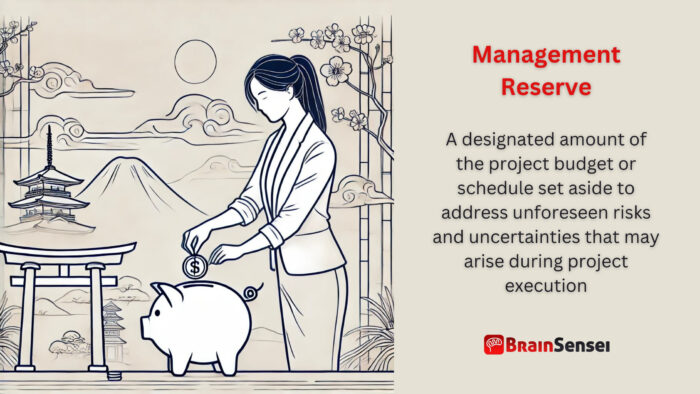
Management Reserve
What is Management Reserve?
A management reserve is a designated amount of the project budget or schedule set aside to address unforeseen risks and uncertainties that may arise during project execution. Unlike a contingency reserve covering known risks, project managers use management reserves for unknown or unexpected events that could impact project objectives. Upper management typically controls this reserve, which is released as needed.
Key Takeaways
- The project uses management reserve to address unforeseen risks outside identified risk management plans.
- It is separate from the contingency reserve, which is for known risks.
- Senior management controls the management reserve, which is not part of the initial project baseline.
- Typically calculated as a percentage of the total project cost or duration.
- Requires formal approval for usage to maintain accountability and oversight.
Understanding Management Reserve
How It Works
A management reserve protects the project from unforeseen risks that are not included in the project risk register. It allows project managers and executives to handle critical challenges without jeopardizing project success. The organization usually holds this reserve at a higher level to prevent unnecessary spending, allocating it only when justifiable circumstances arise.
Important Considerations
- The amount of management reserve varies based on project complexity, industry standards, and organizational policies.
- It is not included in the project’s performance measurement baseline (PMB) but is part of the total project budget.
- Requests for usage typically require documented justification and executive approval.
- Not all projects require a management reserve; they are significantly smaller or low-risk.
Related Terms
- Contingency Reserve: Funds allocated for identified risks with known probabilities and impacts.
- Risk Management Plan: A strategy that outlines how teams identify, analyze, and mitigate risks.
- Change Control Board (CCB): A group responsible for approving changes in scope, budget, or schedule, often including management reserve decisions.
- Earned Value Management (EVM): A project management methodology that tracks performance and may trigger the need for management reserve usage.
- Cost Baseline: The approved budget, excluding management reserve, used to measure cost performance.
Examples of Management Reserve in Action
Manufacturing Industry – Addressing Supply Chain Disruptions
Unexpected supply chain disruptions can halt production and cause significant financial losses in the manufacturing industry. Due to international trade restrictions, a major automobile manufacturer in North America experienced an unforeseen shortage of semiconductor chips. The company had initially planned for potential supply chain risks by allocating a contingency reserve. However, the project management team sought approval to use the management reserve when the situation escalated beyond expected delays and became a prolonged crisis.
Using the reserve, the company quickly secured alternative chip suppliers from other regions, albeit at a higher cost. The additional funds helped prevent a complete shutdown of production lines, allowing the company to continue manufacturing vehicles at a reduced but steady pace. This strategic decision minimized financial losses and enabled the company to maintain relationships with dealers and customers. Properly using the reserve demonstrated the value of proactive financial planning in mitigating unforeseen risks.
Healthcare & Pharmaceuticals – Emergency Drug Development
The pharmaceutical industry is often subject to unpredictable regulatory changes and emerging health crises. A pharmaceutical company was in the late stages of developing a new vaccine when an unexpected virus mutation required additional research and reformulation. The existing project budget did not account for such a drastic change, necessitating the use of the management reserve to continue development.
With the reserve, the company funded urgent clinical trials, procured additional laboratory equipment, and hired specialized researchers to address the mutation’s impact on the vaccine’s efficacy. This timely allocation ensured the project remained on track, avoided regulatory setbacks, and fulfilled public health needs. In this scenario, the role of the reserve underscored its importance in industries where agility and responsiveness to unforeseen risks are critical to success.
Aerospace & Defense – Unexpected Regulatory Compliance Costs
A defence contractor working on a next-generation fighter jet project unexpectedly faced a challenge when new international safety regulations emerged mid-development. These regulations required additional structural testing and modifications not included in the original project scope. Failure to comply with the new standards would result in project delays and potential penalties.
To address this issue, the contractor requested access to the management reserve. The allocated funds covered additional testing costs, engineering changes, and compliance documentation. Without this financial buffer, the project would have faced severe delays and increased costs due to last-minute modifications. The strategic use of the reserve allowed the contractor to meet regulatory requirements without jeopardizing the project timeline, demonstrating its essential role in complex, high-stakes industries.
Use Cases of Management Reserve
North America (Manufacturing)
A car manufacturer unexpectedly encounters a shortage of essential electronic components. The management reserve is accessed to secure alternative suppliers and keep production on schedule. Additionally, an unanticipated quality control failure temporarily halts production, requiring funds from the reserve to expedite testing and adjustments. Without these funds, the company risks missing production deadlines and losing competitive market positioning. Furthermore, unforeseen legal challenges related to new environmental regulations lead to additional compliance costs that must be covered using the reserve.
Europe (Healthcare & Pharmaceuticals)
A pharmaceutical company faces unexpected regulatory changes mid-project. Management reserves help finance additional testing and approval procedures to maintain market launch timelines. In another case, an unexpected pandemic outbreak requires immediate research and adjustments to manufacturing processes, necessitating extra funds for compliance. The company successfully navigates regulatory hurdles by utilizing reserves while ensuring timely product delivery. Additionally, the need for emergency distribution logistics in response to global health crises further exemplifies the crucial role of reserves in ensuring continued operations.
Asia (Telecommunications)
A telecommunications provider faces a cyberattack that disrupts a nationwide network upgrade. The reserved funds pay for emergency cybersecurity measures to restore operations quickly. A separate challenge emerges when a newly introduced government policy requires additional infrastructure modifications, consuming further reserve. The company would struggle to adapt without these reserves, leading to reputational damage and potential financial losses. Additionally, rapid shifts in customer demand necessitate additional software and hardware investments that were not initially accounted for, requiring the allocation of reserve funds to maintain service reliability.
Companies can navigate unforeseen risks by leveraging management reserve across industries while maintaining project timelines, budget integrity, and regulatory compliance.
Best Practices for Management Reserve
Effective management of reserves requires careful planning and oversight. Best practices include:
Defining Clear Guidelines
Establish a documented policy for using reserves and ensure project teams understand how and when they can access funds.
Risk Assessment Integration
Regularly review risk assessments to evaluate whether reserves are sufficient to cover unforeseen events.
Maintaining Separate Accounts
To avoid unintended expenditures, keep management reserves distinct from contingency reserves and operational funds.
Senior Leadership Oversight
Assign senior executives or a financial oversight committee to monitor reserve usage and ensure accountability.
Justification and Documentation
Formal documentation is required for each allocation to prevent misuse and facilitate audits.
Continuous Monitoring
Use financial tracking tools and software to monitor reserve depletion and ensure transparency.
Stakeholder Communication
Keep all key stakeholders informed about reserve usage, reinforcing trust and alignment on budget priorities.
Review and Adjust
Periodically reassess the management reserve needed based on project progress and industry trends.
Training and Awareness
Educate project managers and financial teams on the proper use and importance of management reserves.
Scenario Planning
Develop multiple risk scenarios to predict potential reserve needs, enhancing readiness for unexpected project challenges.
Management Reserve: Common Mistakes and Issues
A common mistake is not distinguishing the difference between management and contingency reserve. The latter covers identified risks with known probabilities, while the former addresses unforeseen risks. Mixing these two types of reserves can lead to incorrect budgeting and an inability to respond effectively to unexpected project challenges.
Another frequent issue is the lack of visibility and awareness among project teams regarding the existence and purpose of the management reserve. If project managers and stakeholders are unaware of the reserve or don’t understand how to request access, they may delay crucial decisions, causing avoidable disruptions.
Poor documentation is another major pitfall. If the reserve usage is not adequately recorded and justified, it can create problems during audits or financial reviews. Organizations must document every request for reserve funds with a clear rationale, explaining why the funds are necessary and how the requestor will use the funds.
Insufficient governance and oversight can also lead to mismanagement of management reserve. Without clear approval processes, funds may be spent inappropriately or depleted too quickly, leaving the project vulnerable to additional unforeseen risks. To prevent this, organizations should establish a formal process where senior management reviews and approves all requests for reserve usage.
Furthermore, some projects allocate management reserves without performing a proper risk analysis. As a result, the project may face cost overruns or inefficient use of funds due to an inadequate or excessive reserve. Conduct a well-structured risk assessment based on industry benchmarks and project complexity to determine an appropriate reserve level.
Another issue arises when organizations fail to adjust management reserves throughout the project lifecycle. While an initial estimate is useful, risks evolve over time, and reserve levels should be periodically reviewed and modified as necessary. Periodic review and adjustment of reserve levels ensure that funds remain available when most needed.
Additionally, some organizations rely too heavily on management reserve instead of actively managing project risks. Rather than treating reserve funds as a last-resort safeguard, organizations should focus on proactive risk mitigation strategies, such as contingency planning and alternative solutions.
Finally, a lack of training on management reserves can lead to improper use or underutilization. Many project managers do not fully understand when and how to access these funds, resulting in premature depletion or excessive hesitancy. Ongoing training and clear guidelines can help teams effectively use management reserves when truly needed.
To mitigate these issues, organizations should:
- Clearly define policies and educate project teams on the proper use of the reserves.
- Maintain transparent documentation and justification for all reserve usage.
- Establish strong governance and approval processes to prevent misuse.
- Regularly assess and adjust reserve levels based on evolving project risks.
- Prioritize proactive risk management instead of relying solely on reserve funds.
- Train project managers and financial teams on best practices for accessing and utilizing the reserve.
Implementing these measures enables organizations to allocate and use management reserves effectively, safeguarding projects against unforeseen risks without unnecessary financial waste or mismanagement.
Frequently Asked Questions (FAQs)
How is management reserve calculated?
Depending on risk factors and policies, organizations often estimate management reserve as a percentage (e.g., 5-10%) of the total project cost.
Who controls the management reserve?
Senior management or project sponsors typically control the management reserve and approve its release based on project needs.
Can management reserve be used for scope changes?
No. Organizations intend to reserve management resources for unforeseen risks, not scope changes. Scope changes require formal change requests and may impact the project baseline.
What happens if the project does not use the management reserve?
If the management reserve remains unused, it can be returned to the organization or reallocated to future projects, depending on company policies.
How does management reserve affect project performance?
When used effectively, management reserve helps mitigate unexpected disruptions, ensuring project timelines and budgets remain intact.
Additional Resources
Preparing for a PMI certification?
- Exam Prep Courses: PMP®, CAPM®, and PMI-ACP®
- Exam Simulators: PMP®, CAPM®, PMI-ACP®, PMI-PBA®, PMI-RMP®, PMI-SP®, PgMP®, and PfMP®
- Professional Development Units (PDUs): 15, 30, and 60 PDU Bundles



